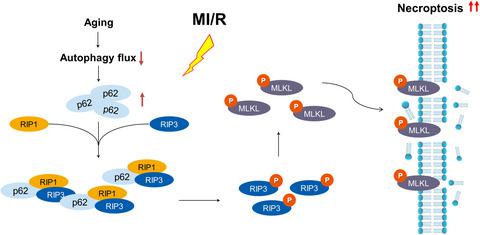当前位置:
X-MOL 学术
›
Aging Cell
›
论文详情
Our official English website, www.x-mol.net, welcomes your
feedback! (Note: you will need to create a separate account there.)
Metformin mediates cardioprotection against aging-induced ischemic necroptosis.
Aging Cell ( IF 8.0 ) Pub Date : 2020-01-14 , DOI: 10.1111/acel.13096 Chen Li 1 , Nan Mu 1 , Chunhu Gu 2 , Manling Liu 1 , Zheng Yang 1 , Yue Yin 1 , Mai Chen 3 , Yishi Wang 1 , Yuehu Han 2 , Lu Yu 4 , Heng Ma 1
Aging Cell ( IF 8.0 ) Pub Date : 2020-01-14 , DOI: 10.1111/acel.13096 Chen Li 1 , Nan Mu 1 , Chunhu Gu 2 , Manling Liu 1 , Zheng Yang 1 , Yue Yin 1 , Mai Chen 3 , Yishi Wang 1 , Yuehu Han 2 , Lu Yu 4 , Heng Ma 1
Affiliation

|
Necroptosis is crucially involved in severe cardiac pathological conditions. However, whether necroptosis contributes to age‐related intolerance to ischemia/reperfusion (I/R) injury remains elusive. In addition, metformin as a potential anti‐aging related injury drug, how it interacts with myocardial necroptosis is not yet clear. Male C57BL/6 mice at 3–4‐ (young) and 22–24 months of age (aged) and RIPK3‐deficient (Ripk3−/−) mice were used to investigate aging‐related I/R injury in vivo. Metformin (125 μg/kg, i.p.), necrostatin‐1 (3.5 mg/kg), and adenovirus vector encoding p62‐shRNAs (Ad‐sh‐p62) were used to treat aging mice. I/R‐induced myocardial necroptosis was exaggerated in aged mice, which correlated with autophagy defects characterized by p62 accumulation in aged hearts or aged human myocardium. Functionally, blocking autophagic flux promoted H/R‐evoked cardiomyocyte necroptosis in vitro. We further revealed that p62 forms a complex with RIP1‐RIP3 (necrosome) and promotes the binding of RIP1 and RIP3. In mice, necrostatin‐1 treatment (a RIP1 inhibitor), RIP3 deficiency, and cardiac p62 knockdown in vivo demonstrated that p62‐RIP1‐RIP3‐dependent myocardial necroptosis contributes to aging‐related myocardial vulnerability to I/R injury. Notably, metformin treatment disrupted p62‐RIP1‐RIP3 complexes and effectively repressed I/R‐induced necroptosis in aged hearts, ultimately reducing mortality in this model. These findings highlight previously unknown mechanisms of aging‐related myocardial ischemic vulnerability: p62‐necrosome‐dependent necroptosis. Metformin acts as a cardioprotective agent that inhibits this unfavorable chain mechanism of aging‐related I/R susceptibility.
中文翻译:

二甲双胍介导抗衰老性缺血性坏死性肾脏病的心脏保护作用。
坏死病严重涉及严重的心脏病理状况。但是,坏死性硬化是否会导致与年龄相关的对缺血/再灌注(I / R)损伤的耐受性尚不清楚。此外,二甲双胍作为一种潜在的抗衰老相关伤害药物,如何与心肌坏死病相互作用尚不清楚。3-4岁(年轻)和22-24个月大(年龄)和RIPK3缺陷(Ripk 3 -/-)小鼠用于研究体内与衰老相关的I / R损伤。二甲双胍(125μg/ kg,ip),坏死抑素-1(3.5 mg / kg)和编码p62-shRNA(Ad-sh-p62)的腺病毒载体用于治疗衰老小鼠。I / R诱发的心肌坏死病在老年小鼠中被夸大,这与自噬缺陷相关,其特征是老年心脏或老年心肌中p62积累。在功能上,阻断自噬通量可在体外促进H / R诱发的心肌细胞坏死。我们进一步揭示p62与RIP1-RIP3(坏死体)形成复合物并促进RIP1和RIP3的结合。在小鼠中,necrostatin-1治疗(一种RIP1抑制剂),RIP3缺乏和体内p62敲低表明,p62-RIP1-RIP3依赖性心肌坏死病可导致衰老相关的心肌对I / R损伤的脆弱性。值得注意的是 二甲双胍治疗可破坏p62-RIP1-RIP3复合物并有效抑制I / R诱导的老年心脏坏死,最终降低该模型的死亡率。这些发现突显了与衰老相关的心肌缺血性损伤的先前未知的机制:p62坏死体依赖性坏死性肾病。二甲双胍可作为一种心脏保护剂,抑制这种与衰老相关的I / R敏感性的不利链机制。
更新日期:2020-01-14
中文翻译:

二甲双胍介导抗衰老性缺血性坏死性肾脏病的心脏保护作用。
坏死病严重涉及严重的心脏病理状况。但是,坏死性硬化是否会导致与年龄相关的对缺血/再灌注(I / R)损伤的耐受性尚不清楚。此外,二甲双胍作为一种潜在的抗衰老相关伤害药物,如何与心肌坏死病相互作用尚不清楚。3-4岁(年轻)和22-24个月大(年龄)和RIPK3缺陷(Ripk 3 -/-)小鼠用于研究体内与衰老相关的I / R损伤。二甲双胍(125μg/ kg,ip),坏死抑素-1(3.5 mg / kg)和编码p62-shRNA(Ad-sh-p62)的腺病毒载体用于治疗衰老小鼠。I / R诱发的心肌坏死病在老年小鼠中被夸大,这与自噬缺陷相关,其特征是老年心脏或老年心肌中p62积累。在功能上,阻断自噬通量可在体外促进H / R诱发的心肌细胞坏死。我们进一步揭示p62与RIP1-RIP3(坏死体)形成复合物并促进RIP1和RIP3的结合。在小鼠中,necrostatin-1治疗(一种RIP1抑制剂),RIP3缺乏和体内p62敲低表明,p62-RIP1-RIP3依赖性心肌坏死病可导致衰老相关的心肌对I / R损伤的脆弱性。值得注意的是 二甲双胍治疗可破坏p62-RIP1-RIP3复合物并有效抑制I / R诱导的老年心脏坏死,最终降低该模型的死亡率。这些发现突显了与衰老相关的心肌缺血性损伤的先前未知的机制:p62坏死体依赖性坏死性肾病。二甲双胍可作为一种心脏保护剂,抑制这种与衰老相关的I / R敏感性的不利链机制。











































 京公网安备 11010802027423号
京公网安备 11010802027423号